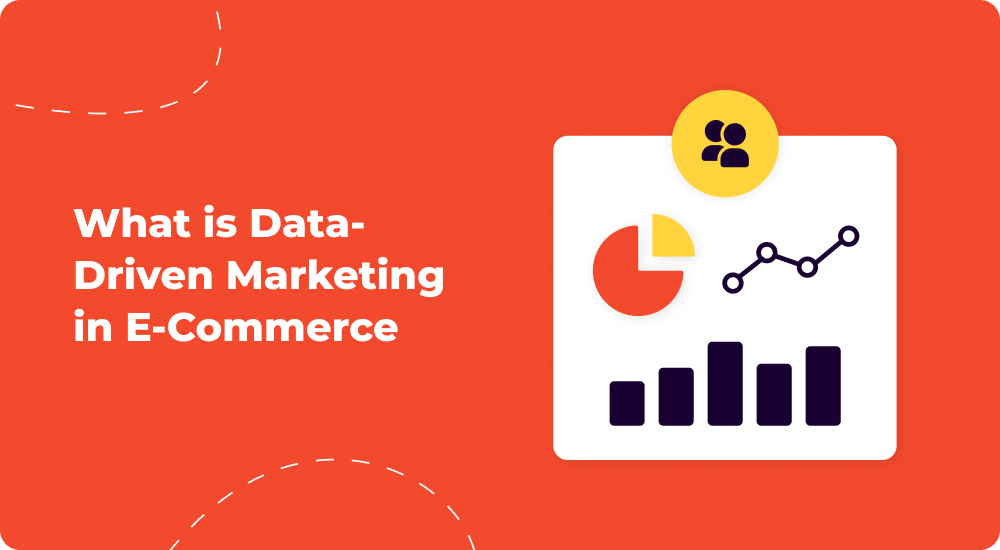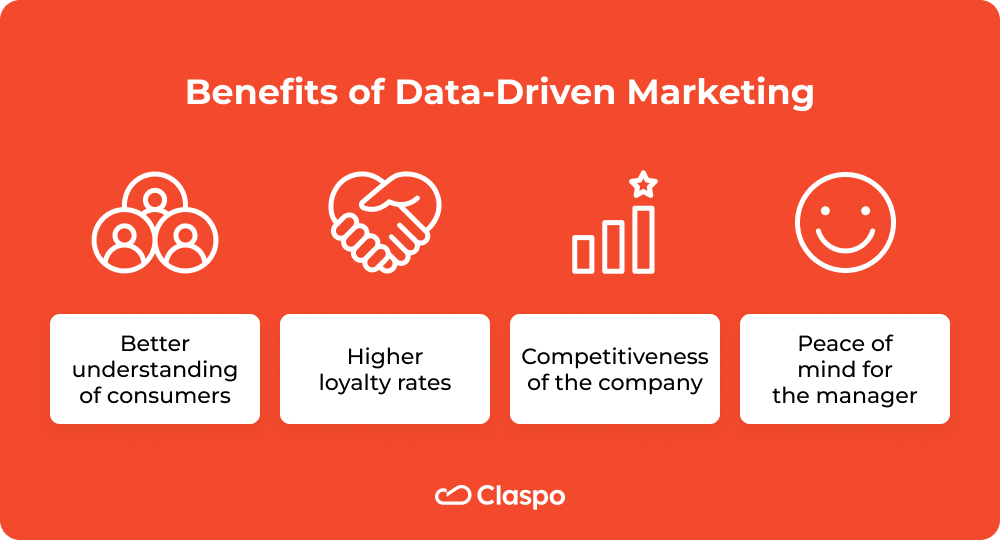Data-Driven Marketing for E-Commerce: Benefits, Trends, Examples
In today's information-rich business environment, it is important to use data-driven marketing techniques for successful growth. Analysis of big data volumes allows companies to study their customers, understand their needs, and create convenient and personalized products or services.
Data-driven marketing helps to effectively direct advertising efforts and brings innovations to the strategic decision-making process. In this article, we'll consider the main ideas and benefits of using data-driven marketing techniques to increase the competitiveness of your e-commerce business.
What is Data-Driven Marketing in E-Commerce

Google statistics show that 72% of successful companies use a data-driven marketing approach. This is not surprising since, according to Invesp, they receive 4-8 times higher return on investment (ROI). Let us explain how such methods work, what benefits they provide, what examples to follow, and which trends to follow.
Data-Driven Marketing Definition
Data-driven marketing is collecting, storing, and using customer information to predict their behavior and choose the best sales strategy. In fact, it is about personalizing advertising campaigns. By knowing the key characteristics of your audience, their needs, requirements, and aspirations, businesses can create much more effective messages, reducing the cost of disseminating the message and increasing the return on investment.
A data-driven marketing approach involves using an analytics system instead of intuition, guesses, and hypotheses of managers. It should take into account many factors that can affect customer relationships, such as characteristics of the target audience, market dynamics, and a company's business model. The analysis process should be iterative or continuous. Ideally, it requires automation that will allow you to instantly run certain scenarios in case of changing circumstances, minimizing reaction time and staying ahead of most competitors.
Why is Data-Driven Marketing Important for E-Commerce
Data-driven marketing allows you to more accurately develop advertising campaigns for a solvent target audience that needs a company product and is ready to make a purchase. This enables you to reduce the amount of contextual advertising, the volume of email campaigns, and investments in affiliate programs while achieving the expected result.
Data-driven marketing statistics collected by Zipdo demonstrate the importance of this approach:
- personalization of advertising messages can increase user engagement by 74%;
- 77% of consumers prefer brands that offer a personalized customer journey based on collected data;
- the use of an automated analytics system increases the advertising campaign's links clickability by 75%;
- data-driven marketing allows the spreading of information about a brand, improving its reputation 50% faster;
- 64% of marketing directors believe personalized advertising is the best business advantage in highly competitive markets.
Benefits of Data-Driven Marketing
It may sound paradoxical, but not all benefits of using quantitative information can be quantified. Some of the benefits of data-driven marketing impact the effectiveness of advertising campaigns and financial results, but it's very difficult to describe them with specific figures. So, let's talk about them in more detail.
A better understanding of consumers
To set up personalized advertising campaigns, you first need to segment your customer base and clearly define the characteristics of each group of customers. You can create their portraits by describing the smallest details, from typical daily routines to desires and aspirations. This will help optimize the company's business model by improving pricing and product policy, updating the product range, and changing the approach to staff training.
Higher loyalty rates
By understanding your customers, you can choose the best retention methods, such as discount coupons, newsletters with helpful information, holiday greetings, etc. One of the advantages of data-driven marketing is that it leads to hyper-personalization, which allows you to choose the perfect tactics for working with each customer as an individual. Thanks to this, you don't have to devote too much time and attention to this work - a modern analytics system will automatically run scripts.
Competitiveness of the company
The market never stands still - it is constantly changing, forcing businesses to adapt. Data-driven marketing allows you to continuously monitor current trends, consumer preferences, and competitors' prices. This means you can stay one step ahead by predicting changes and developing new strategies in advance rather than catching up with them and losing money.

Peace of mind for the manager
Last but not least, data-driven marketing benefits include lower stress levels. A company leader can sleep peacefully knowing that the business model is flexible enough to adapt to most changes. Even if something unexpected occurs in the market, such as a global price increase or an innovative product launch, the company will survive with minimal losses.
Examples of Data-Driven Marketing for E-Commerce
Setting up an analytics system gives you access to a wide variety of tools. Here are some data-driven marketing examples with proven effectiveness.
1. Website widgets
Widgets are an effective marketing tool, as e-commerce sites with widgets show 70% higher sales. However, achieving such a result is possible only by adapting them to the needs and interests of your audience and its segments. That's why Claspo offers you essential tools to study and understand them:
- Built-in analytics. Study the number of views and conversions, as well as the conversion rate of each widget in your account. Based on this data, you can not only evaluate the performance of your widgets but also build hypotheses about why some perform better than others.
- A/B testing. Put your hypotheses into practice to understand what factors help or hinder conversions—text, design, placement, time of widget appearance, and more. Regular A/B testing will allow you to get enough data about what works best for your audience and thus optimize your widget strategy.
- Integration with Google Analytics. By integrating Claspo with Google Analytics, you can transfer key performance indicators of your widgets to a single data repository and evaluate them in conjunction with other marketing efforts. As a result, you see a complete picture of the customer journey on the website and can make comprehensive changes to your online strategy.

2. Hyperpersonalization of the site
Thanks to modern technologies, you don't have to limit yourself to individual offers and product recommendations. Artificial intelligence allows you to customize your website for each visitor. A neural network will generate the necessary images, design elements, and text content by analyzing user characteristics in real time.
Booking.com uses one of the best data-driven marketing solutions. It studies each user's search and booking history, changing the website's background. If a client is more likely to look for accommodation by the sea, there will be tropical landscapes. If a customer is interested in historical centers, the portal will show the most famous monuments of human civilization.
Currently, there are many tools for hyper-personalization of websites, such as PersonalizeFX, Dynamic Yield, and Personyze. But it's worth remembering that they require careful customization, testing, and control. The line between attracting and scaring away customers can be very fine.
3. Email-recommendations
The information collected can be used to encourage repeat purchases. Top companies such as Sephora and Amazon customize their email campaigns very accurately. They use the following data-driven email marketing tools:
- cross-selling - recommending products similar to those purchased earlier;
- upsells - reminders that it's time to buy a product that is about to expire;
- personalized selections - recommendations based on visits and orders of a particular user;
- reviews of popular products - lists of products with the number of sales for the last week or month;
- personalized discounts, coupons, and promo codes - to motivate people to return to the platform as soon as possible.
4. Page-by-page optimization
Conversion rates in e-commerce are usually uneven. Individual pages of a website can be leaders or outsiders. Usually, their performance differs several times. This gap can be seen as a characteristic feature of the industry or a potential for optimization.
Tools like Hotjar allow you to analyze every page of a web resource. Using them, you can see which elements are most often used by visitors, how long they study the content, and when they leave the site. Examples that help businesses increase conversion include:
- replacing the standardized greeting with a photo of a smiling company employee;
- simplifying the size line of clothing;
- preserving the basic configuration of computers when viewing different types of assemblies;
- changing the color of buttons on the landing page;
- increasing the size of the customer service contact icon.
Future of Data-Driven Marketing for E-Commerce
One of the current data-driven marketing trends is the use of artificial intelligence. Now, it allows you to personalize the company message and commercial offer. In the future, its use may extend to the entire customer journey. AI will automatically generate attractive contextual advertising, choose the best communication channel for orders, and automatically provide the necessary information without waiting for a support request. This will significantly increase conversion rates and loyalty and reduce customer migration between brands.
One of the other data-driven marketing insights is the increasing role of Big Data and machine learning. Predictive models are already being used to forecast customer behavior and fill in gaps in their characteristics. Increasing computing power will significantly improve the accuracy of this process in the future, reducing the error from today's 15-25% to 1-5%.
Currently, a data-driven marketing strategy can be inaccurate because customers use multiple gadgets, sometimes with different operating systems and accounts. The development of predictive models will make it possible to link these accounts, making marketing tools more efficient, including selecting the best communication channels.
Data-Driven Marketing for E-Commerce: How Can Claspo Help
As mentioned above, Claspo has extensive functionality for collecting and analyzing data — built-in analytics, A/B testing, and integration with Google Analytics. Based on this data, you can:
- Determine optimal widget display scenarios, including time and place of appearance, frequency of display, appropriate context, and where they show the best result.
- Develop effective content by understanding how separate elements of your widget affect the result. Maybe the call-to-action button should be bigger and more prominent to drive conversions?
- Understand your audience better. You may have thought that by offering constant discounts, you are guaranteed to increase sales, but, in fact, your potential customers want something else - more product reviews or a hassle-free return guarantee.
- Personalize your offers. Claspo allows you to target your widgets to first-time site visitors or those who have navigated from a specific marketing campaign, advertisement, communication channel, etc. You can create the most effective offer for each segment through testing and analysis and take your sales to a new level.
Build your website widget strategy with Claspo and always rely on data to enhance it!












